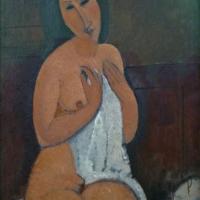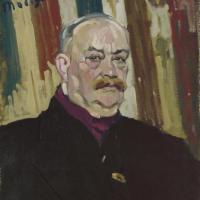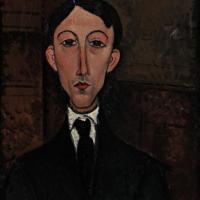Amedeo Modigliani
Max Jacob
$450.00
Mme G. Van Muyden
$450.00
Moishe Kisling
$450.00
Nu Assis A La Chemise
$450.00
Nude With Hat
$450.00
Nudo Sdraiato
$450.00
Paul Guillaume
$450.00
Portrait De Joseph Levi
$450.00
Portrait De Roger Dutilleul
$450.00
Portrait Of Anna Zborowska
$450.00
Portrait Of Celso Lagar
$450.00
Portrait Of Chaim Soutine
$450.00
Portrait Of Diego Rivera
$450.00
Portrait of Diego Riviera
$450.00
Portrait Of Manuel Humbert
$450.00
Portrait Of Maud Abrantes
$450.00
Portrait Of Mme Zborowska
$450.00
Portrait of Moise Kisling
$450.00
Amedeo Modigliani
Amedeo Modigliani (1884-1920)
Amedeo Clemente Modigliani (12 July 1884 – 24 January 1920) was an ItalianJewish painter and sculptor who worked mainly in France. He is known for portraits and nudes in a modern style characterized by elongation of faces, necks, and figures that were not received well during his lifetime but later found acceptance. Modigliani spent his youth in Italy, where he studied the art of antiquity and the Renaissance. In 1906 he moved to Paris, where he came into contact with such artists as Pablo Picasso and Constantin Brâncuși. By 1912 Modigliani was exhibiting highly stylized sculptures with Cubists of the Section d'Or group at the Salon d'Automne.
Modigliani's œuvre includes paintings and drawings. From 1909 to 1914 he devoted himself mainly to sculpture. His main subject was portraits and full figures, both in the images and in the sculptures. Modigliani had little success while alive, but after his death achieved great popularity. He died of tubercular meningitis, at the age of 35, in Paris.
Although a series of Modigliani's sculptures were exhibited in the Salon d'Automne of 1912, by 1914 he abandoned sculpting and focused solely on his painting, a move precipitated by the difficulty in acquiring sculptural materials due to the outbreak of war, and by Modigliani's physical debilitation.
In June 2010 Modigliani's Tête, a limestone carving of a woman's head, became the third most expensive sculpture ever sold.
The Paris show of 1917 was Modigliani's only solo exhibition during his life, and is "notorious" in modern art history for its sensational public reception and the attendant issues of obscenity. The show was closed by police on its opening day, but continued thereafter, most likely after the removal of paintings from the gallery's streetfront window.
Nude Sitting on a Divan is one of a series of nudes painted by Modigliani in 1917 that created a sensation when exhibited in Paris that year. According to the catalogue description from the 2010 sale of the painting at Sotheby's, seven nudes were exhibited in the 1917 show.
Nu couché realized $170,405,000 at a Christie's, New York, sale on 9 November 2015, a record for a Modigliani painting and placing it high among the most expensive paintings ever sold.
On a trip to Nice which had been conceived and organized by Zborowski, Modigliani, Foujita and other artists tried to sell their works to rich tourists. Modigliani managed to sell a few pictures, but only for a few francs each. Despite this, during this time he produced most of the paintings that later became his most popular and valued works.
During his lifetime, he sold a number of his works, but never for any great amount of money. What funds he did receive soon vanished for his habits.
In the spring of 1917, the Russian sculptor Chana Orloff introduced him to a beautiful 19-year-old art student named Jeanne Hébuterne who had posed for Tsuguharu Foujita. From a conservative bourgeois background, Hébuterne was renounced by her devout Roman Catholicfamily for her liaison with Modigliani, whom they saw as little more than a debauched derelict. Despite her family's objections, soon they were living together.
Modigliani ended his relationship with the English poet and art critic Beatrice Hastings and a short time later Hébuterne and Modigliani moved together into a studio on the Rue de la Grande Chaumière. Jeanne began to pose for him and appears in several of his paintings. Jeanne Hébuterne became a principal subject for Modigliani's art.
On December 3, 1917, Modigliani's first one-man exhibitionopened at the Berthe Weill Gallery in Paris. The chief of the Paris police was scandalized by Modigliani's nudes and forced him to close the exhibition within a few hours after its opening.
Towards the end of the First World War, early in 1918, Modigliani left Paris with Hébuterne to escape from the war and travelled to Nice and Cagnes-sur-Mer. They would spend a year in France. During that time they had a busy social life with many friends, including Pierre-Auguste Renoir, Pablo Picasso, Giorgio de Chirico and André Derain.
After he and Hébuterne moved to Nice on November 29, 1918, she gave birth to a daughter whom they named Jeanne (1918–1984). In May 1919 they returned to Paris with their infant daughter and moved into an apartment on the rue de la Grande Chaumière.
Hébuterne became pregnant again. Modigliani then got engaged to her, but Jeanne's parents were against the marriage, especially because of Modigliani's reputation as an alcoholic and drug user. However, Modigliani officially recognized her daughter as his child. The wedding plans were shattered independently of Jeanne's parents' resistance when Modigliani discovered he had a severe form of tuberculosis.
Although he continued to paint, Modigliani's health deteriorated rapidly, and his alcohol-induced blackouts became more frequent.
In 1920, after not hearing from him for several days, a neighbour checked on the family and found Modigliani in bed delirious and holding onto Hébuterne. A doctor was summoned, but little could be done because Modigliani was in the final stage of his disease, tubercular meningitis. He died on January 24, 1920, at the Hôpital de la Charité.
There was an enormous funeral, attended by many from the artistic communities in Montmartre and Montparnasse. When Modigliani died, twenty-one-year-old Hébuterne was eight months pregnant with their second child.
A day later, Hébuterne was taken to her parents' home. There, inconsolable, she threw herself out of a fifth-floor window, a day after Modigliani's death, killing herself and her unborn child. Modigliani was buried in Père Lachaise Cemetery. Hébuterne was buried at the Cimetière de Bagneux near Paris, and it was not until 1930 that her embittered family allowed her body to be moved to rest beside Modigliani. A single tombstone honors them both. His epitaph reads: "Struck down by death at the moment of glory". Hers reads: "Devoted companion to the extreme sacrifice".
Managing only one solo exhibition in his life and giving his work away in exchange for meals in restaurants, Modigliani died destitute.
In November 2010, a painting of a nude by Amedeo Modigliani, part of a series of nudes he created around 1917, sold for more than $68.9m (£42.7m) at an auction in New York—a record for the artist's work. Bidding for La Belle Romaine pushed its price well past its $40m (£24.8m) estimate. Modigliani's previous auction record was 43.2m euros (£35.8m), set earlier in 2010 in Paris. Another painting by the artist—Jeanne Hébuterne (au chapeau), one of the first portraits he painted of his lover—sold for $19.1m (£11.8m), much higher than its pre-sale estimate of $9–12m (£5.6–7.4m).
On November 9, 2015 the 1917 painting Nu couché, sold at Christie's in New York for US$170.4 million. On May 14, 2018 the 1917 painting Nu couché (sur le côté gauche) sold at Sotheby's in New York for $157.2 million. This was the highest auction price in Sotheby's history.


























